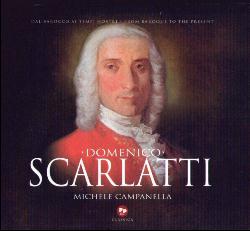|
A
very special "sound" for very special music. On an 1870
Pleyel, played by Gioachino Rossini,
Michele Campanella recreates
12 sonatas from "Exercises for Harpsicord" by Domenico
Scarlatti.
(First edition: London 1738)
Excerpts
from the original CD booklet:
Scarlatti’s known work ammounts to 555 compositions of which
most are in a single tempo. Only thirty were published directly
by the author - the "Essercizi per Gravicembalo" which
appeared in London in 1738. A few other were printed in Amsterdam,
Paris and Nuremberg while he was still alive under the titles
"Sonate", "Lezioni" and "Pièces pour le Clavecin". When published
in London they were called "Voluntaires" and were probably intended
as improvisations to be played during the intervals of church
services. Scarlatti never threw light upon the origins of these
varying and imprecise titles. He let things be. Silent, absent
and unreachable in his own private world.
 The sonatas
are one of the highest and most original expressions of eighteenth
century music. From their first moment of impact we are struck
by their extraordinary variety of sound and by the great inventive
capacity of the composer. They are short pieces which through
a highly virtuous set of veritable musical fire-works bring to
the fore a world of sensations, of realistic references and allusions
which appear and reappear in kaleidoscopic fashion. The sonatas
are one of the highest and most original expressions of eighteenth
century music. From their first moment of impact we are struck
by their extraordinary variety of sound and by the great inventive
capacity of the composer. They are short pieces which through
a highly virtuous set of veritable musical fire-works bring to
the fore a world of sensations, of realistic references and allusions
which appear and reappear in kaleidoscopic fashion.
 They probably
began as exercices for the then Princess Maria Barbara di Braganza,
the future Queen of Spain, to whom Scarlatti gave music lessons.
They were certainly intended for a very narrow circle of listeners.
Their performance on the pianoforte greatly enriches their expression
because this instrument brings out all the original intentions
of the author - aims and goals which are rather muted in the light
and graceful sound of the harpsichord. The piano serves to bring
out to the utmost their expressive character and their latent
virtuosity. They probably
began as exercices for the then Princess Maria Barbara di Braganza,
the future Queen of Spain, to whom Scarlatti gave music lessons.
They were certainly intended for a very narrow circle of listeners.
Their performance on the pianoforte greatly enriches their expression
because this instrument brings out all the original intentions
of the author - aims and goals which are rather muted in the light
and graceful sound of the harpsichord. The piano serves to bring
out to the utmost their expressive character and their latent
virtuosity.
 We do not
know the chronology of the compositions. In the unsigned manuscript
copies which are kept in the Biblioteca Nazionale Marciana in
Venice no dates are indicated. We do not
know the chronology of the compositions. In the unsigned manuscript
copies which are kept in the Biblioteca Nazionale Marciana in
Venice no dates are indicated.
Other
excerpts from the original CD booklet:
"About a year ago I talked to Maestro Campanella about the
idea of employng the pianoforte as a means by which to "revisit"
some of the most important of Scarlatti’s Sonatas for the harpsichord.
He seemed to me to be immediately interested in the idea and told
me that he would think deeply about what was required to ensure
that this important artistic project was brought to fruition.
In presenting this compact disc to the public I think it would
be of interest for the listener to know some of the - albeit brief
- observations made by Michele Campanella
after he had finished working on this most valuable recording."
(G. Acquisti)

"Five
of the sonatas of the ten presented in this compactdisc have a
slow andamento and three of these are presented here with brilliant
sonatas. I have sought to draw attention to a less well-known
but extemely important Scarlatti: the Scarlatti of melancholy
and recollections-feelings which despite the obvious stereotypes
are typically Mediterranean in character.
 The Pleyel
made in 1870 which I chose for this compact disc evidently, enough
is not an attempt to imitate the harpsichord of Scarlatti’s original
intention. As an instrument it is as distant from the harpsichord
as is a Steinway of our times. But the austere tonal choice which
the Pleyel imposes acts to shift the attention of the player and
the listener onto other values-first and foremost the movement
of dance which is implicit in every sonata, each andamento, and
the unprecedented imagination of Scarlatti the harmoniser who
is able in his moments of melodic suspension to achieve effects
of authentic hypnosis". The Pleyel
made in 1870 which I chose for this compact disc evidently, enough
is not an attempt to imitate the harpsichord of Scarlatti’s original
intention. As an instrument it is as distant from the harpsichord
as is a Steinway of our times. But the austere tonal choice which
the Pleyel imposes acts to shift the attention of the player and
the listener onto other values-first and foremost the movement
of dance which is implicit in every sonata, each andamento, and
the unprecedented imagination of Scarlatti the harmoniser who
is able in his moments of melodic suspension to achieve effects
of authentic hypnosis".
(M. Campanella)
|

